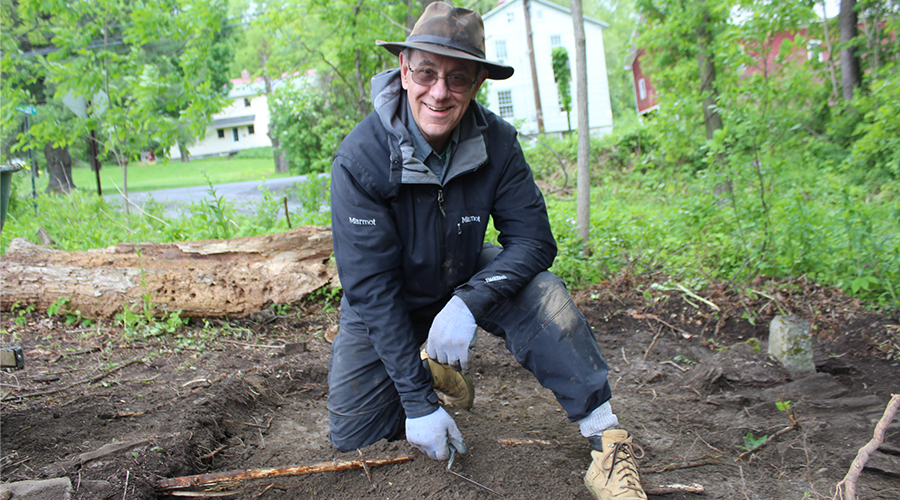
The new NOVA episode “Great Mammoth Mystery” starts with a find by two amateur fossil hunters on a private site in Swindon, southwest England. “Britain has a long history of archeological hobbyists,” explains archaeologist Dr. Peter G. Gould (Master of Liberal Arts ’10), speaking about the documentary. The couple uncovered several mammoth bones and, nearby, a Neanderthal hand axe chipped from flint. “The two folks who found this stuff expressed a major interest in working with DigVentures rather than with the conventional academic or commercial archeology teams,” Peter continues, “so DigVentures was authorized to do the first rounds of excavations, raised the funding, and we’ve been there for three years so far.” Peter is an equity partner and the financial director for DigVentures, an innovative archeological social enterprise.
The documentary, hosted by acclaimed broadcaster and natural historian Sir David Attenborough, goes on to recount the excavation’s progress and share expert opinions about what it may reveal. Five sets of mammoth remains and numerous small, sharpened flint tools have been uncovered at the site. This close proximity between stone tools and mammoth bones is extremely rare and has the potential to change what we know about early humans and their relationship with the extinct cousins of elephants deep in the Ice Age over 200,000 years ago. Did Neanderthals hunt or slaughter these mammoths? Two and a half million viewers tuned in the day the episode aired last December in the UK to learn more about the dig at Swindon, which now appears to be one of the most significant Neanderthal sites in Britain.
Peter’s enthusiasm about archaeology is evident as he describes the importance of the finds from Swindon and engaging both local and global citizens in cultural heritage. His resume, however, reveals a long career in economics and finance: a stint with the Brookings Institution, economic advising during the Carter administration, and years in investment banking, leveraged buyouts, and venture capital. Along the way, Peter became an active philanthropist, including chairing the boards at the Philadelphia Zoo and the city’s Mann Music Center. So how did he become involved in archaeology and DigVentures?
“My wife sent me back to school to figure out what I was going to do when I retired so I wasn’t underfoot,” Peter quips. “Penn’s Master of Liberal Arts program is perfectly suited for someone who is trying to figure out what to do with his or her life. I went in without any preconceived notions of what I was going to do.”
Peter’s experience at Penn quickly reignited an interest in history he had as an undergraduate. In one of his first courses, Peter met the then-director of the Penn Museum, which led to an invitation to join the Penn Museum Board of Advisors. As he customized his MLA curriculum, Peter chose heritage and archeology courses, earning a Global Studies Certificate along the way. “I got very interested in the economic theories relating to community self-organization,” he explains. His MLA capstone project took him to Belize to study community development around heritage sites.
Energized by his master’s studies, Peter went on to earn a PhD in archaeology in 2014 from University College London, where he continued to investigate the connections between public archaeology, local communities, and economic development.
While Peter was completing his PhD, his advisor connected him with archaeologist Lisa Westcott Wilkins. She and her husband Brendon Wilkins—a fellow archaeologist—were launching an unconventional business geared toward enabling and improving public participation with archaeology called DigVentures. Perhaps Peter would want to get involved? “Before I got into archaeology, I worked with smaller businesses that were trying to do novel things or improve their business model. I am a proponent of venture capital-type thinking in archeology,” he reflects. “DigVentures had two first-class people running it, and it seemed to me that it was worth a flyer to see how it works. And it has worked extremely well.” Peter joined as an equity partner and the financial director, providing an investment boost for the fledgling company as well as offering his fundraising and business expertise, helping to troubleshoot the types of problems that come up when running a small and growing enterprise. “Brendon and Lisa are the drivers of the organization. I’m along for the ride,” Peter insists. (You can catch the Wilkinses leading the Swindon excavation in “Great Mammoth Mystery.”)
The Swindon excavation was staffed only by professionals and kept relatively quiet until the documentary, due in part to the potential importance of the site. But what sets DigVentures apart is its mission and model to engage the public. Most of their projects leverage crowdfunding and crowdsourcing to bring in financial support from individuals as well as labor and even expertise. “The blend of in-person with virtual participation is the hallmark of what we do,” Peter explains. Another notable difference between DigVentures and other similar organizations is that all of their projects, including the digs, are self-generated and led by the team rather than being a recruiting service for universities or field schools. DigVentures posts projects on their website and invites people to provide financial support and even come on site to dig. Archaeological courses and training are available online. And while digs are taking place, DigVentures maintains a steady stream of social media content—watch parties for the amateur and pro alike—which can lead to near real-time, crowdsourced answers from across the globe to questions that come up on site. In the last decade, DigVentures has hosted about 100 projects with almost 3,900 field participants, 27,000 digital participants, and 1 million social media engagements. During 2021’s COVID shutdown, their online archaeology festival drew 3,300 participants from 61 countries to learn about 34 projects in 26 countries—truly global impact. Since 2012, DigVentures has raised £2 million in crowd and matched grant funding for projects.
In addition to joining DigVentures, Peter’s new life as an archaeologist has included publishing three books and numerous articles, teaching and lecturing around the world, and other professional achievements. And his involvement with Penn didn’t end with his degree. He has taught a course on heritage and economics at Penn. He helped craft the MLA Cultural Heritage Management Certificate. And he is now the chair of the Penn Museum Board of Advisors and serves as a consulting scholar at the Penn Cultural Heritage Center.
“I wouldn’t be doing anything I’m doing today if I hadn’t done the Penn MLA,” he concludes.
NOVA’s “Great Mammoth Mystery” episode aired on PBS in the United States on February 16, 2022. Check online for available streaming.



